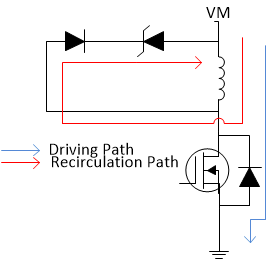SLVAE59A February 2019 – April 2022 DRV8242-Q1 , DRV8243-Q1 , DRV8244-Q1 , DRV8245-Q1 , DRV8343-Q1 , DRV8702-Q1 , DRV8702D-Q1 , DRV8703-Q1 , DRV8703D-Q1 , DRV8803 , DRV8804 , DRV8805 , DRV8806 , DRV8860 , DRV8873 , DRV8873-Q1 , DRV8874 , DRV8874-Q1 , DRV8876 , DRV8876-Q1 , DRV8935 , DRV8955
3.2.2 Passive Voltage Clamping
Common passive components used for voltage clamping of inductive loads are zener diodes or TVS diodes. The voltage across an inductive load can be described by Equation 1. During recirculation, the voltage across the inductor is mainly due to any changes in current, minus the voltage drop due to load current through internal resistance of solenoid.
To simplify further, internal resistance of the solenoid is ignored, the decay time can be estimated by Equation 2.
Assuming inductance and current are constant during recirculation, this shows that the decay time is inversely related to voltage across inductive load; the larger the voltage, the smaller the decay time. For the case of freewheeling or slow decay, this voltage would just be the forward voltage of diode. Again, for fast decay with full-bridge, this voltage would be VSUPPLY plus forward voltage of two diodes. For quick turn-off or clamping with a zener diode, this voltage would be forward voltage of diode plus VZENER, where VZENER can be much larger than VSUPPLY.
Figure 3-6 shows the recirculation path when using a Zener diode for fast discharging. Note that the voltage on one node of the solenoid is VM, and the other node is VDIODE + VZENER + VM, making the total voltage across the solenoid equal to VDIODE + VZENER.
 Figure 3-6 Zener Diode Fast Discharging
Circuit
Figure 3-6 Zener Diode Fast Discharging
Circuit